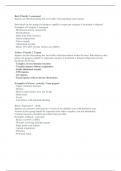Red- Priority 1-emergent
Injuries are life-threatening but survivable with immediate intervention.
Individuals in this group can progress rapidly to expectant category if treatment is delayed.
Examples of Catagory 1-emergent
- Mechanical airway obstruction
- Pneumothorax
- Open long bone fractures
- Partial amputations
- Chest wounds
- Abdominal wounds
- Burns 15%-40% of body surface area (BSA)
Yellow- Priority 2 Urgent
Injuries are life-threatening but survivable with intervention within the hour. Individuals in this
group can progress rapidly to expectant category if treatment is delayed. Expected wait for
treatment 45-60 min
- Complex, lower extremity fractures
- Vascular injuries without compromise
- Stable abdominal wounds
- CNS injuries
- GU injuries
- Facial injuries with no airway obstructions
Examples of Green - priority 3 non-urgent:
- Upper extremity fractures
- Sprains
- Burns (small surface area, not facial)
- Behavioral
- Psych
- Lacerations with minimal bleeding
Black- Expectant 4 - death
Injuries are extensive and chances of survival are unlikely even with definitive care.
Persons in this group should be separated from other casualties, but not abandoned.
Comfort measures should be provided when possible.
Examples of Black - expectant
- Burns over 60% of BSA
- Wounds involving multiple organs
- High spinal cord injuries
- Agonal respirations
- Pulseless
- Profound shock
,Unresponsive patient with penetrating head wounds -Black
Small lacerations without significant bleeding- green
Tension pneumothorax-red
maxillofacial wounds without airway compromise-yellow
Incomplete amputations-red
Vascular injuries with adequate collateral circulation -yellow
2 & 3 degree burns over 60% of body -black
Behavioral disorders or psychological disturbances -green
Fractures requiring open reduction -yellow
Open fractures of the long bone-red
1. Michael works as a triage nurse, and four clients arrive at the
emergency department at the same time. List the order in which he will
assess these clients from first to last.
1. A 50-year-old female with moderate abdominal pain and occasional
vomiting.
2. A 35-year-old jogger with a twisted ankle, having a pedal pulse and
no deformity.
3. An ambulatory dazed 25-year-old male with a bandaged head
wound.
4. An irritable infant with a fever, petechiae, and nuchal rigidity.
A. 1, 2, 3, 4
B. 2, 1, 3, 4
C. 4, 3, 1, 2
D. 3, 4, 2, 1
2. In conducting a primary survey on a trauma patient, which of the
following is considered one of the priority elements of the primary
survey?
,A. Initiation of pulse oximetry.
B. Complete set of vital signs.
C. Client’s allergy history.
D. Brief neurologic assessment.
3. A 65-year-old patient arrived at the triage area with complaints of
diaphoresis, dizziness, and left-sided chest pain. This patient should be
prioritized into which category?
A. Non-urgent.
B. Urgent.
C. Emergent.
D. High urgent.
4. You respond to a call for help from the ED waiting room. There is an
elderly patient lying on the floor. List the order for the actions that you
must perform.
1. Call for help and activate the code team.
2. Instruct a nursing assistant to get the emergency cart.
3. Initiate cardiopulmonary resuscitation (CPR).
4. Perform the chin lift or jaw thrust maneuver.
5. Establish unresponsiveness.
A. 5, 2, 4, 3, 1
B. 1, 5, 2, 4, 3
C. 1, 2, 5, 4, 3
D. 5, 1, 4, 3, 2
5. In caring for a victim of sexual assault, which task is most
appropriate for an LPN/LVN?
, A. Provide emotional support and supportive communication.
B. Assess immediate emotional state and physical injuries.
C. Ensure that the “chain of custody” is maintained.
D. Collect hair samples, saliva swabs, and scrapings beneath fingernails.
6. You are caring for a client with a frostbite on the feet. Place the
following interventions in the correct order.
1. Immerse the feet in warm water 100° F to 105° F (40.6º C to 46.1°
C).
2. Remove the victim from the cold environment.
3. Monitor for signs of compartment syndrome.
4. Apply a loose, sterile, bulky dressing.
5. Administer a pain medication.
A. 5, 2, 1, 3, 4
B. 2, 5, 1, 4, 3
C. 2, 1, 5, 3, 4
D. 3, 2, 1, 4, 5
7. Following an emergency endotracheal intubation, nurses must verify
tube placement and secure the tube. List in order the steps that are
required to perform this function?
1. Obtain an order for a chest x-ray to document tube placement.
2. Confirm that the breath sounds are equal and bilateral.
3. Auscultate the chest during assisted ventilation.
4. Secure the tube in place.
A. 1, 2, 3, 4
B. 4, 3, 2, 1
C. 3, 2, 4, 1
D. 4, 1, 2, 3




